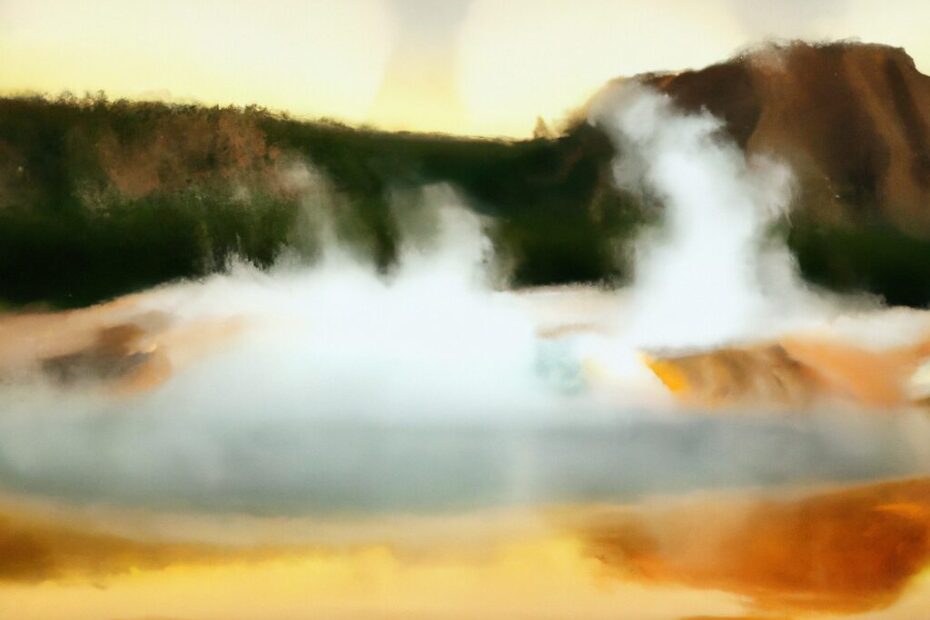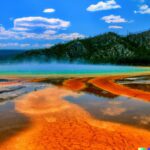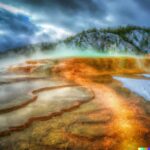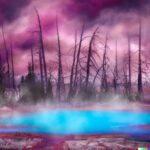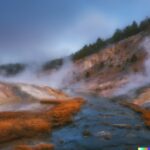Short Answer:
Long Answer:
Hey there, curious minds! Ever wondered if Yellowstone National Park is secretly hiding a fiery secret beneath its bubbling geysers? Well, buckle up because we’re about to embark on a wild ride through the world of geology to uncover the truth about lava and geysers in this iconic park!
Picture this: You’re standing on the edge of a steaming pool, watching in awe as water shoots skyward like a natural fountain. Suddenly, your buddy turns to you and asks, “Hey, do you think there’s lava lurking beneath all this bubbling action?” It’s a valid question, considering Yellowstone’s reputation for geothermal wonders and its fiery past. But before we jump to conclusions, let’s dive deep into the science behind geysers and lava to separate fact from fiction.
What Are Yellowstone Geysers?
Yellowstone geysers are unique geothermal features found in Yellowstone National Park, showcasing the power of volcanic processes and the Earth’s geothermal energy.
The geysers in Yellowstone are the result of water seeping deep into the ground, where it is heated by molten rock below the Earth’s surface. This superheated water then rises back to the surface, creating the iconic eruptions that visitors marvel at. These geothermal features are a visible reminder of the intense geothermal activity that lies beneath the park.
Yellowstone’s geysers play a crucial role in releasing pressure from the volcanic system, preventing catastrophic eruptions and helping to maintain the delicate balance of the region’s geothermal ecosystem.
What Causes Geysers to Erupt?
The eruption of geysers is primarily caused by the interaction of underground heat sources with geologic formations, leading to spectacular volcanic eruptions of water and steam.
These fascinating natural phenomena occur when underground water is heated by magma or hot rocks, resulting in intense pressure buildup. As the water nears boiling point, it expands rapidly, seeking a way to escape. When the pressure becomes too great for the confining rock, the geyser erupts, releasing a powerful combination of boiling water and steam into the air. This process bears striking similarities to volcanic eruptions, where molten rock (magma) beneath the surface builds up pressure until it finally erupts through the Earth’s crust.
What Is the Role of Heat and Pressure in Geyser Eruptions?
Heat and pressure play a crucial role in geyser eruptions, as the heat source from geologic formations interacts with underground water reservoirs, leading to intense pressure build-up and eventual eruptions.
This intricate process involves geothermal energy being transferred from the Earth’s interior towards the surface, where it heats underground water and creates a boiling-hot reservoir beneath the ground. As this superheated water becomes pressurized due to the heat, it seeks any available pathway to relieve this pressure, often resulting in spectacular geyser eruptions. The volcanic deposits in the area, along with the natural heat flow patterns, further shape the dynamics of geyser formations, making them a fascinating and powerful display of the Earth’s geothermal activity.
How Does Water Get Trapped in Geyser Chambers?
Water gets trapped in geyser chambers through intricate hydrothermal systems that involve the storage and circulation of water within geothermal reservoirs, forming a complex network of underground hydrothermal systems.
These hydrothermal systems play a crucial role in the functioning of geysers by heating trapped water deep within the Earth’s crust, causing it to rise and accumulate in geyser chambers. The pressure build-up from the heated water, combined with the confinement within the geyser’s narrow channels, results in intermittent eruptions of steam and water. Geologists analyze these systems using various techniques, such as monitoring temperature gradients and conducting chemical composition studies, to gain a deeper understanding of the dynamics at play in geyser formations.
What Is Lava?
Lava is molten rock that emerges from volcanoes during eruptions, shaping geological wonders and preserving a record of volcanic history within its hardened formations.
This molten rock, known as magma when beneath the Earth’s surface, plays a crucial role in volcanic activity and the creation of diverse landforms. As lava flows and cools, it solidifies into various types of igneous rocks, forming landscapes like basalt plateaus, volcanic cones, and even volcanic islands. The composition of lava, determined by the type of volcano and the minerals present in the magma, influences the characteristics of the resulting land features, showcasing the intricate interplay of geological processes.
What Is the Composition of Lava?
The composition of lava varies based on the type of volcano and its eruption history, influencing the formation of unique volcanic deposits, landforms, and contributing to ongoing geological processes.
The diverse compositions of lava, including basaltic, andesitic, rhyolitic, and other types, play a significant role in shaping the Earth’s surface.
Basaltic lava, rich in iron and magnesium, flows more fluidly and can create extensive lava plateaus and shield volcanoes.
In contrast, andesitic lava, with higher silica content, tends to be more viscous, forming stratovolcanoes with steep slopes and explosive eruptions.
Rhyolitic lava, the most viscous type, can lead to the formation of domes and ash-flow tuffs, altering landscapes dramatically.
Understanding how these distinct lava compositions interact with the environment is crucial for predicting volcanic hazards and studying geological evolution.
Can Lava Come From Yellowstone Geysers?
Ah, Yellowstone National Park, a place of wonder and mystery! It’s not uncommon for visitors to wonder if the geysers in this iconic park are conduits for flowing lava. After all, Yellowstone is nestled atop a supervolcano with a fiery reputation. However, the truth might surprise you.
Geysers, those majestic columns of boiling water and steam, are not typically associated with lava. Instead, they are the result of a unique interplay of geological forces. Deep beneath the surface of Yellowstone lies a network of magma chambers, where molten rock simmers and heats groundwater. When this superheated water encounters a pathway to the surface, usually through fractures in the Earth’s crust, it erupts in a dazzling display of natural beauty.
While Yellowstone’s geysers are indeed connected to the park’s volcanic activity, they are not channels for lava flow. Lava, which is molten rock that erupts onto the Earth’s surface during volcanic eruptions, typically emerges from fissures or vents in the ground, rather than from geysers. So, while Yellowstone’s geysers offer a glimpse into the park’s geothermal wonders, they do not spew forth rivers of lava.
In essence, while the thought of lava flowing from Yellowstone’s geysers may ignite the imagination, the reality is that these geothermal features showcase the park’s unique hydrothermal activity, providing a window into the Earth’s dynamic and ever-changing landscape.
Are There Any Volcanoes in Yellowstone National Park?
Yellowstone National Park harbors the famous Yellowstone Caldera, a supervolcano that indicates intense tectonic activity and stands as one of the world’s geological wonders.
The presence of volcanoes within the park creates a unique environment that draws in visitors from all over the globe. The supervolcano aspect of Yellowstone Caldera has been the subject of scientific fascination, with researchers closely monitoring any signs of potential eruptions.
The tectonic activity in the area contributes to the geothermal features that make Yellowstone so extraordinary, from bubbling hot springs to impressive geysers like Old Faithful. These geological wonders are a testament to the dynamic forces shaping our planet beneath the surface.
What Is the Connection Between Yellowstone Geysers and Volcanoes?
The connection between Yellowstone geysers and volcanoes lies in their shared geological history, showcasing a landscape shaped by volcanic activity and offering opportunities for geology exploration.
The stunning geysers of Yellowstone National Park are not just beautiful natural wonders but also windows into the region’s volcanic past. Exploring these geysers can provide insights into the underlying volcanic processes that have shaped the landscape over millions of years.
The geothermal features like geysers and hot springs offer a unique opportunity for visitors to witness the dynamic relationship between the Earth’s crust and the magma reservoirs beneath. This interaction between volcanoes and geysers is a testament to the geological significance of Yellowstone as a hotspot for scientific research and education.
Does Yellowstone National Park Have a History of Volcanic Activity?
Yellowstone National Park is not just a picturesque landscape; it’s also a geological marvel shaped by a rich history of volcanic activity. For millions of years, this area has been a hotbed of volcanic eruptions, leaving behind a legacy that continues to shape the park’s landscape today.
The park sits atop the Yellowstone Caldera, a massive volcanic crater formed by a series of cataclysmic eruptions over the past two million years. These eruptions, known as supereruptions, were among the most powerful volcanic events in Earth’s history, spewing vast quantities of ash and lava across the region. The most recent supereruption occurred approximately 640,000 years ago and had a profound impact on the landscape, leaving behind the iconic features that define Yellowstone today.
While supereruptions are rare and occur on timescales of hundreds of thousands to millions of years, Yellowstone remains an active volcanic system. Beneath the surface, a vast reservoir of molten rock, known as magma, continues to fuel the park’s geothermal features, including geysers, hot springs, and fumaroles. While the likelihood of another supereruption occurring in the near future is extremely low, the ongoing presence of magma beneath the surface serves as a reminder of Yellowstone’s volcanic past and its potential for future activity.
Despite the potential risks associated with volcanic activity, Yellowstone’s geological wonders attract millions of visitors each year, drawn by the opportunity to witness nature’s power and beauty up close. By studying the park’s volcanic history and monitoring its current activity, scientists strive to better understand the complex processes that shape our planet and mitigate the risks posed by volcanic hazards. So, while Yellowstone’s volcanic history may be ancient, its influence on the park’s landscape and ongoing geothermal activity continue to fascinate and inspire visitors from around the world.
How is Volcanic Activity monitored in Yellowstone?
Signs of potential volcanic activity in Yellowstone are monitored through seismic monitoring, assessing volcanic hazards, and evaluating geothermal impacts to predict and mitigate risks associated with volcanic events.
Seismic monitoring plays a crucial role in detecting any ground movement or tremors that could indicate magma movement beneath the surface. By analyzing the frequency, magnitude, and location of earthquakes, scientists can better understand the dynamics of the volcanic system.
Volcanic hazard assessment involves studying the history of past eruptions, the composition of magma beneath Yellowstone, and the potential scenarios for future volcanic activity. Geothermal activity in the region, characterized by hot springs and geysers, also provides insights into the underground volcanic processes occurring in the area, aiding in risk mitigation strategies.
What Are the Current Monitoring Systems in Place for Yellowstone Volcano?
Yellowstone Volcano is extensively monitored through advanced systems that track volcanic activity, conduct geothermal measurements, and analyze geothermal features to enhance scientific understanding and preparedness.
These monitoring systems play a crucial role in detecting any changes in the volcano’s behavior, allowing scientists to predict potential eruptions and protect nearby communities. Volcanic activity tracking involves the constant observation of seismicity, ground deformation, gas emissions, and thermal anomalies.
Geothermal measurements help in assessing the heat flow and underground pressure within the volcano, providing valuable insights into its inner workings. The analysis of geothermal features, such as hot springs and geysers, offers clues about the volcano’s plumbing system and potential eruption mechanisms.
How Do Scientists Predict Volcanic Eruptions in Yellowstone?
Scientists utilize cutting-edge technologies such as geothermal imaging, investigative studies, and mapping techniques to predict volcanic eruptions in Yellowstone based on geothermal anomalies and geologic assessments.
These innovative methods provide valuable insights into the complex processes occurring beneath the surface of the Yellowstone Caldera. Geothermal imaging allows scientists to detect subtle changes in temperature and underground structures that may indicate volcanic activity.
Investigative approaches involve analyzing gas emissions, seismicity patterns, and hydrothermal systems to identify potential precursors to an eruption. Mapping technologies play a crucial role in visualizing the evolving geology of the region, helping researchers track changes in hotspot activity and assess the overall volcanic hazard potential.
By integrating data from these different sources, scientists can develop more accurate models for forecasting volcanic events in Yellowstone. However currently, a likelihood of an eruption ay Yellowstone is extremely rare.
Frequently Asked Questions
1) Does Lava Come From Yellowstone’s’ Geysers?
No, lava does not come from Yellowstone Geysers. The geysers in Yellowstone are fed by underground hot springs and not volcanoes.
2) Are the geysers in Yellowstone connected to volcanic activity?
No, the geysers in Yellowstone are not connected to volcanic activity. They are a result of the unique geological features of the area, such as the presence of a large underground reservoir of hot water.
3) Can lava be seen in Yellowstone National Park?
No, lava cannot be seen in Yellowstone National Park. The last major volcanic eruption in the park occurred over 640,000 years ago, and there is no current volcanic activity in the park.
4) How do geysers in Yellowstone form?
The geysers in Yellowstone form when groundwater is heated by hot rocks deep underground, creating steam that rises to the surface and erupts as a geyser. This process is known as hydrothermal activity.
5) Are there any active volcanoes in Yellowstone?
No, there are no active volcanoes in Yellowstone National Park. The park is home to several dormant volcanoes, but there has not been any volcanic activity in the park for hundreds of thousands of years.
6) Are there any risks of volcanic eruptions in Yellowstone?
While there is no current volcanic activity in Yellowstone, there is a low risk of future volcanic eruptions in the park. However, the Yellowstone Volcano Observatory closely monitors the area for any signs of potential volcanic activity.
Last Updated on February 18, 2024 by Jon Waraas – Originally Posted: February 11, 2024

I’m Jon Waraas, and I’ve been navigating the online world since 2006. By day, I’m the proud owner of some eCommerce gems, and by night, I’m the voice behind the adventures on Waraas.Com.
My heart, however, belongs to the wild beauty of Yellowstone National Park. I’ve got a collection of websites dedicated to sharing the wonders of this natural masterpiece. Oh, and did I mention? I’m currently building my own cabin inside the ghost town of Gilmore, Idaho – a cabin with tales to tell!
When I’m not immersed in the digital realm, you’ll find me lacing up my boots for a good hike or setting up camp under the star-studded sky.
